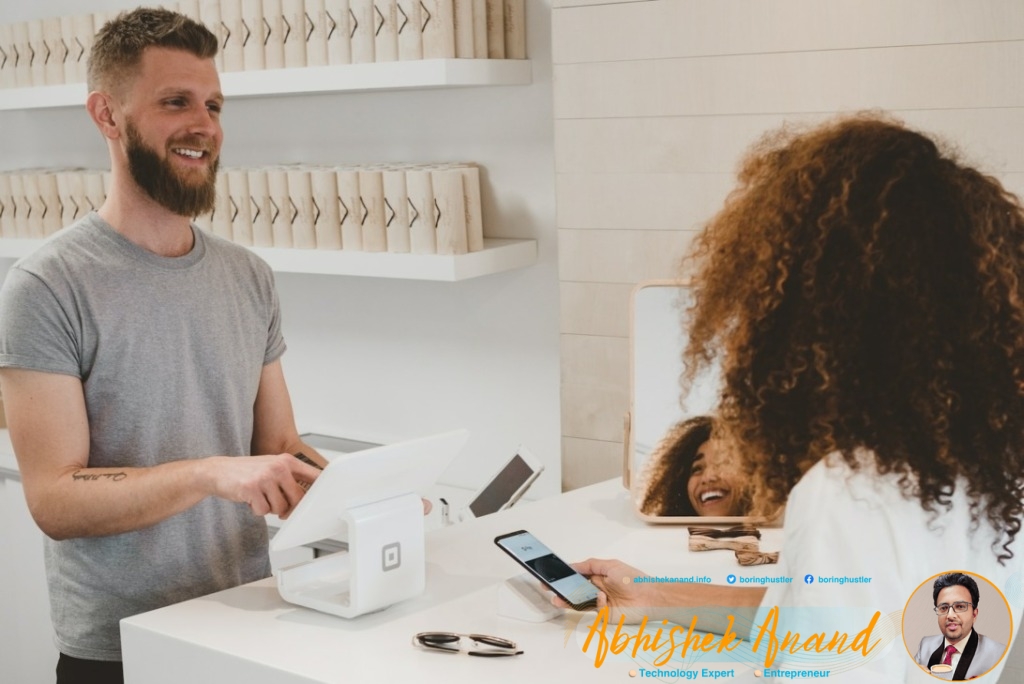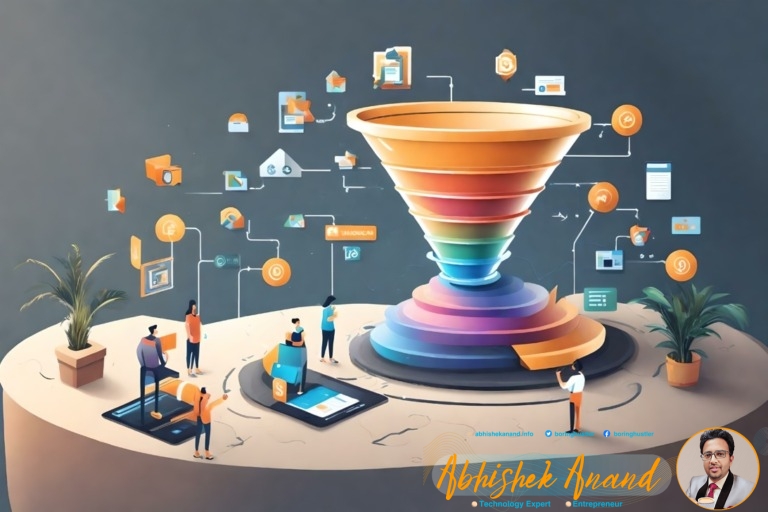Did you know that the average conversion rate for SaaS websites is only 2.35%? That means out of every hundred visitors to your website, only two or three are likely to become paying customers. As a SaaS business owner, this statistic can be daunting, but it doesn’t have to be.
By optimizing your sales funnel, you can increase your conversion rates and drive more revenue for your business. In this article, we will explore strategies for maximizing conversions in each stage of the sales funnel. From understanding your target audience to providing flexible pricing options, we will provide actionable tips and insights to help you improve your SaaS sales funnel and achieve better results. So let’s dive in!

Understanding Your Target Audience
Understanding your target audience is crucial for optimizing your SaaS sales funnel, as it allows you to tailor your messaging and approach to their specific needs and pain points. One key aspect of understanding your audience is identifying target personas. These are fictional representations of your ideal customers that help you visualize and empathize with their unique characteristics, behaviors, motivations, and challenges.
To create accurate target personas, you need to conduct market research using various methods such as surveys, interviews, focus groups, social media listening tools, website analytics data, etc. This research will give you insights into the demographics (age, gender, location), psychographics (values, beliefs, interests), buying behavior (purchasing habits, decision-making criteria), pain points (challenges they face), aspirations (goals they want to achieve) of your potential customers.
By knowing who your target audience is and what drives them to purchase a SaaS product like yours or not; you can optimize every stage of the sales funnel from lead generation to post-purchase nurturing. Crafting compelling landing pages comes next in the process of optimizing your SaaS sales funnel.
Crafting Compelling Landing Pages
To optimize your saas sales funnel, crafting compelling landing pages is crucial. Understanding landing page best practices and implementing A/B testing are key points to focus on. You can increase conversions by creating a clear value proposition, using attention-grabbing headlines, and simplifying the design of your landing page.
Understanding Landing Page Best Practices
Landing pages are crucial for increasing conversions, so it’s important to know the best practices that will make them effective. The design of your landing page plays a significant role in attracting and retaining visitors, which is why you need to ensure that it looks professional and visually appealing. To achieve this, consider using eye-catching headlines, relevant images or videos, and clear calls-to-action. You can also optimize your landing page by removing any distractions that may hinder your visitors from taking action.
In addition to design elements, there are other optimization techniques you can use to improve the effectiveness of your landing page. One approach is to create a sense of urgency by adding countdown timers or limited-time offers. Another technique is to add social proof such as customer testimonials or trust badges to build credibility and trust with your audience. By following these best practices, you can increase the likelihood of converting visitors into customers on your landing page. As you continue to optimize your funnel, implementing A/B testing can help you identify which strategies work best for maximizing conversions.
Implementing A/B Testing
Get ready to put your website under the microscope and find out what works best for you by implementing A/B testing – it’s like a science experiment for your online presence! By comparing two different versions of a webpage, you can measure their effectiveness and optimize performance based on the results. This method involves randomly splitting your website traffic into two groups, with one group seeing the original version of your page (control) and the other seeing a modified version (variant). You can then track how each group interacts with the pages and use this data to make informed decisions about what changes to implement.
A/B testing is an essential tool for optimizing conversions in your SaaS sales funnel. It enables you to identify which elements of your landing page are working well and which ones need improvement. For example, you may want to test different headlines, images or calls-to-action to see which ones resonate better with your audience. By making small changes that result in more clicks or sign-ups, you can significantly increase the overall conversion rate of your website. Once you have optimized your landing page using A/B testing, it’s time to move onto nurturing leads with email campaigns.

Nurturing Leads with Email Campaigns
You’ll love how email campaigns can help you nurture your leads and increase conversions. By implementing effective segmentation and lead scoring techniques, you can tailor your emails to specific groups of leads based on their interests, behaviors, and level of engagement with your brand. This personalized approach not only increases the likelihood of conversions but also helps build trust and loyalty with your audience.
Segmentation involves dividing your email list into smaller groups based on common characteristics such as demographics, behavior patterns, or preferences. By doing so, you can send targeted messages that resonate with each group’s unique needs. Lead scoring is a technique that assigns points to leads based on their interactions with your website and emails. This allows you to prioritize follow-up efforts and focus on the most promising prospects.
To make the most out of email campaigns, it’s essential to create compelling content that speaks directly to your audience’s pain points and aspirations. Use attention-grabbing subject lines, clear calls-to-action, and visually appealing designs to keep subscribers engaged. Also, don’t forget to track metrics such as open rates, click-through rates, and conversion rates to evaluate performance continually.
As you optimize your email campaigns for maximum impact, remember that they are just one piece of the puzzle when it comes to converting leads into customers. The next step is optimizing your website for conversions by creating an intuitive user experience that guides visitors towards taking action.
Optimizing Your Website for Conversions
When visitors land on your website, they form an impression within 50 milliseconds, making it crucial to have a well-designed and user-friendly site that encourages conversions. Website optimization is the process of improving the usability and performance of your website to increase its effectiveness in achieving business goals. One way to optimize your website for conversions is by conducting conversion rate analysis.
Conversion rate analysis involves tracking and analyzing user behavior on your website to identify areas where visitors are dropping off or not engaging with content. With this data, you can make informed decisions about how to improve the customer experience and increase conversions. For example, if you notice that many users abandon their shopping cart during checkout, you might simplify the checkout process or offer incentives like free shipping.
To optimize your website for conversions, consider implementing tactics such as clear calls-to-action, simplified navigation menus, fast page load times, mobile responsiveness, and high-quality content. By constantly monitoring and testing different elements of your site based on conversion rate analysis results, you can continually improve its ability to convert visitors into customers.
As important as optimizing your website is for conversions, utilizing social media for lead generation can be just as effective. In today’s digital age where most people spend a significant amount of time on social media platforms such as Facebook and Twitter every day, it’s no surprise that businesses are increasingly using these platforms to attract potential leads.

Utilizing Social Media for Lead Generation
To effectively generate leads through social media, you need to understand which platforms your target audience frequents most. Once you’ve identified the platform(s), focus on creating engaging content that resonates with your followers and encourages them to take action. This can include sharing valuable resources, highlighting customer success stories, and offering exclusive promotions or discounts. By strategically utilizing social media for lead generation, you can increase your brand’s visibility and ultimately drive more conversions.
Understanding Which Platforms to Focus On
If you’re looking to maximize conversions in your SaaS sales funnel, it’s important to understand which platforms are worth focusing on. The first step towards effective platform selection is conducting a thorough target persona analysis. You need to know who your ideal customer is, what their pain points are, and where they spend most of their time online.
Once you have a clear understanding of your target audience, the next step is to identify the social media platforms that align with their preferences and behaviors. For instance, if your target customers are millennials or Gen Zers, Instagram and TikTok might be more effective for reaching them than LinkedIn or Twitter. Ultimately, by selecting the right social media platforms for your SaaS business, you can increase the visibility of your product and attract qualified leads into your sales funnel.
When it comes to creating engaging social media content that resonates with your target audience, there are several strategies you can employ. However, before diving into content creation tactics such as using eye-catching visuals or crafting witty captions, it’s crucial to define your brand voice and messaging framework. By establishing a consistent tone across all social channels and aligning your messaging with the needs of your prospects, you can build trust and credibility with potential customers from the outset.
Creating Engaging Social Media Content
Engaging your audience on social media requires a consistent brand voice and messaging framework. With so many businesses vying for attention on these platforms, it can be challenging to stand out from the crowd. One strategy that can help is visual storytelling, which involves using images or videos to convey your message in a way that captures people’s attention and emotions. By telling stories about your product or service through visual mediums, you can create a more memorable experience for your audience and increase engagement.
Another effective tactic is to use hashtag campaigns, which are essentially marketing initiatives centered around a specific hashtag. These campaigns encourage users to create content related to your brand or industry and share it with their followers using the designated hashtag. By leveraging user-generated content in this way, you can expand your reach and build buzz around your brand. Remember that the key to success with social media content is consistency – posting regularly and responding promptly to comments and messages will help you cultivate a loyal following of engaged customers.
Providing exceptional customer service is crucial for keeping these customers happy and converting them into paying users of your SaaS solution.
Providing Exceptional Customer Service
You can’t afford to provide mediocre customer service – it’s essential for building trust and loyalty with potential customers. In fact, studies show that 86% of consumers are willing to pay more for a better customer experience. When your customers feel valued and heard, they are more likely to become brand advocates and refer others to your business.
So how can you provide exceptional customer service? It starts with communication. Ensure that your team is trained on active listening, empathy, and problem-solving skills. Respond promptly to inquiries and complaints, whether through email, phone, or social media channels. Take the time to personalize responses and follow up with customers to ensure their satisfaction.
Building trust is another crucial aspect of providing excellent customer service. Be transparent about your products or services, pricing structures, and policies. If an issue arises, own up to it and offer solutions or compensation where appropriate. By prioritizing communication and trust-building in your customer service strategy, you will be well on your way towards maximizing conversions in your sales funnel.
Transitioning into the subsequent section about leveraging customer testimonials: Happy customers who receive exceptional service are more likely to leave positive reviews or testimonials about their experience with your product or service. These reviews can serve as valuable social proof for other potential customers considering making a purchase from you. So how can you leverage these testimonials effectively?

Leveraging Customer Testimonials
You’ve done a great job providing exceptional customer service, but there’s more you can do to optimize your SaaS sales funnel. One way is by leveraging customer testimonials. When potential customers see that others have had success with your product, it builds trust and increases the likelihood of conversion.
Customer testimonials are a powerful tool in showcasing success. They provide social proof that your product or service works and can deliver on its promises. When gathering testimonials, make sure to highlight specific results or benefits that the customer experienced. This will help potential customers understand how they could benefit from using your product.
To maximize the impact of customer testimonials, consider including them throughout your sales funnel. Place them on your website’s homepage, product pages, and even in email campaigns. The more exposure potential customers have to positive feedback from real users, the more likely they are to convert into paying customers.
As you continue optimizing your SaaS sales funnel, offering free trials or demos is another effective strategy for increasing conversions. By allowing potential customers to try before they buy, you’re giving them a risk-free opportunity to experience the value of your product firsthand.
Offering Free Trials or Demos
Offering a free trial or demo is like inviting someone to test drive a car before making the purchase – it allows potential customers to experience the value of your product firsthand and increases the likelihood of them becoming paying customers. By providing a glimpse into your software’s user experience, you can showcase how beneficial it can be for their business. The trial length should be long enough for users to fully understand the capabilities of your software, but not too long that they lose interest in using it.
Conversion rates are often higher when companies offer free trials or demos compared to those who don’t. However, it’s important to have a follow-up process in place after the trial period ends. This ensures that users are aware of all available features and services while also addressing any concerns they may have had during their trial period. A well-designed follow-up process will help guide potential customers towards purchasing your product.
In summary, offering a free trial or demo is an effective strategy for maximizing conversions as it provides potential customers with an opportunity to experience the value of your product firsthand. By ensuring that users have access to all available features and services during their trial period and having a strong follow-up process in place afterwards, you can increase the likelihood of converting them into paying customers. In the next section, we’ll discuss implementing referral programs as another way to optimize your SaaS sales funnel.
Implementing Referral Programs
Implementing referral programs can be a fun and effective way to incentivize your existing customers to spread the word about your product and bring in new business. Here are some strategies for creating a successful referral program:
Offer rewards that are valuable but not too expensive: Incentivizing customers is crucial, but it’s important to keep costs under control. Consider offering discounts on future purchases or exclusive access to premium features.
Make the referral process easy: You want your customers to be excited about referring their friends and colleagues, so make sure the process is simple and straightforward. Provide clear instructions on how to refer, and consider using automated tools like referral links or social media sharing buttons.
Personalize the experience: People are more likely to refer others if they feel like they’re part of a community or have a personal connection with your brand. Consider adding personal touches like customized messages or personalized landing pages for referred leads.
Test and adjust: Referral programs require ongoing attention and optimization. Keep track of metrics like conversion rates, reward costs, and customer feedback, and don’t be afraid to adjust your approach as needed.
By implementing an effective referral program structure, you can tap into the power of word-of-mouth marketing while also rewarding your loyal customers. But remember that this is just one piece of the puzzle – next up we’ll discuss how analyzing and adjusting your sales funnel can further optimize conversions for your SaaS business!
Analyzing and Adjusting Your Sales Funnel
To optimize your sales funnel and increase conversions, it’s crucial to track key metrics such as website traffic, lead generation, and customer acquisition. By analyzing these metrics, you can identify areas for improvement and adjust your sales funnel accordingly. This data-driven approach enables you to continuously refine your strategy, improve the customer experience, and ultimately drive more revenue for your business.
Tracking Key Metrics
You can easily keep track of your sales funnel performance by monitoring key metrics such as website traffic, lead generation, and conversion rates. This allows you to identify areas for improvement and make data-driven decisions that optimize your funnel’s conversion rate.
To effectively track your sales funnel performance, consider using the following metrics:
Website Traffic: Monitor how many visitors are coming to your site and which pages they visit most frequently.
Lead Generation: Track the number of leads generated through various channels such as email campaigns or social media advertising.
Conversion Rates: Measure how many visitors take action on your site, such as filling out a form or making a purchase.
Funnel Visualization: Analyze the progression of visitors through each stage of your funnel, identifying where drop-offs occur and why.
By paying close attention to these metrics, you can gain valuable insights into how well your sales funnel is performing and where you may need to make adjustments. In the next section, we will explore strategies for identifying areas for improvement in more detail.
Identifying Areas for Improvement
It’s time to take a closer look at where your sales process may be falling short, so that you can make the necessary adjustments and see better results. Identifying pain points in your sales funnel is critical to improving conversions. Are there areas where potential customers are dropping off? Are they getting stuck or confused during the buying process? Pinpointing these issues will help you determine which parts of your funnel need the most attention.
One effective way to gather information about pain points is by conducting customer surveys. Ask customers who have already gone through the buying process what they found helpful and what could be improved upon. Their feedback can provide valuable insights into areas that need tweaking, such as website navigation, pricing concerns, or even missing features. By identifying and addressing these pain points, you can create a smoother and more effective sales funnel that leads to higher conversions.
Now that you’ve identified areas for improvement in your sales funnel, it’s time to focus on creating valuable content that resonates with potential customers.

Creating Valuable Content
By crafting engaging and informative content, businesses can boost their saas sales funnel conversion rates. A solid content strategy is essential for attracting potential customers to your website and keeping them engaged throughout the buyer’s journey. Your content should be tailored to your target audience’s needs, pain points, and interests. Conducting thorough ROI analysis will help you identify which types of content are resonating with your audience and driving the most conversions.
To create valuable content that converts visitors into leads, consider incorporating these strategies:
Use clear and concise language that is easy to understand
Address common pain points or challenges faced by your target audience
Provide actionable tips or advice that readers can implement right away
Incorporate visuals such as images, videos, or infographics to enhance engagement
By adopting these tactics in your content creation process, you can increase the likelihood of converting visitors into loyal customers. Remember to continually evaluate the performance of your content through analytics tools and adjust your strategy accordingly.
Providing personalized product recommendations is another key step in optimizing your saas sales funnel conversion rates. By tailoring recommendations based on a customer’s past behavior or preferences, you can increase the chances of upselling or cross-selling additional products. Keep reading to learn more about this strategy and how it can benefit your business.
Providing Personalized Product Recommendations
You can take your SaaS sales funnel optimization to the next level by implementing recommendation engines and sending personalized emails based on customer behavior. By using recommendation engines, you can suggest products or services that are relevant to each individual customer’s needs and preferences, increasing the likelihood of a purchase. Personalized emails based on customer behavior can also help drive conversions by providing tailored content that resonates with each customer’s interests and previous actions on your website or app.
Implementing Recommendation Engines
Boost your conversion rates by implementing recommendation engines – they can provide personalized suggestions to potential customers, increasing the likelihood of a sale. Two common types of recommendation engines are collaborative filtering and content-based filtering. Collaborative filtering involves suggesting products based on other users’ behavior and preferences, while content-based filtering suggests products based on the attributes of the items themselves.
To implement a recommendation engine, you’ll need to collect data on user behavior such as browsing history, search queries, and purchase history. This data can then be used to create personalized recommendations for each user. By providing relevant product suggestions tailored to their interests, you increase the chances of converting them into paying customers.
Sending personalized emails based on customer behavior is another effective strategy for boosting conversions. By analyzing their interactions with your website or app, you can tailor messages that speak directly to their interests and needs. This approach increases engagement and encourages repeat purchases over time.
Sending Personalized Emails Based on Customer Behavior
Improve your email marketing game by tailoring messages to your customers’ behavior, making them feel valued and understood. Behavior-based segmentation allows you to divide your customer base into groups based on their actions, preferences, and interests. This information can be used to create targeted messaging that speaks directly to the recipient’s needs and desires.
Sending personalized emails based on customer behavior can increase open rates, click-through rates, and ultimately lead to more sales conversions. By segmenting your audience and crafting specific messages for each group, you are showing that you understand their individual needs and value them as a customer. This approach can also help improve retention rates by keeping customers engaged with relevant content. With behavior-based segmentation in place, you can now move on to emphasizing the benefits of your product in order to further drive conversions.
Emphasizing the Benefits of Your Product
Highlighting the advantages of your product is crucial to persuading potential customers to make a purchase. You need to showcase how your product can transform their lives and catapult them to success. By highlighting the unique features and benefits of your product, you can convince customers that it’s worth investing in.
One way to emphasize the benefits of your product is by using data-driven examples. For instance, if you’re selling a project management tool, highlight how much time users can save by using it. Showcasing such statistics will make it easier for customers to understand why they need your product in their lives.
Moreover, don’t be afraid to get creative when highlighting the advantages of your product. If possible, use customer testimonials or case studies to demonstrate how others have benefitted from using your product. By doing so, you’ll appeal more directly to potential customers who are seeking proof that what you’re offering works. With this approach firmly established, it’s time to move on and explore other ways of optimizing conversions – namely by offering flexible pricing options.
Offering Flexible Pricing Options
When it comes to optimizing your SaaS sales funnel, offering flexible pricing options is key. Creating tiered pricing plans can help appeal to a wider range of customers with different needs and budgets. Additionally, offering discounts and promotions can incentivize potential customers to make the leap and commit to your product. By implementing these tactics, you can increase conversions and ultimately drive revenue for your business.
Creating Tiered Pricing Plans
Offering different pricing tiers can give customers the flexibility to choose the plan that best fits their needs and budget. With customization options, you can create tiers that cater to specific customer segments and their unique requirements. The key is to base your pricing on value rather than cost, so customers feel they are getting a fair deal.
Here are three ways creating tiered pricing plans can optimize your SaaS sales funnel:
Appeal to different customer segments: By offering multiple tiers with varying features and benefits, you can attract a wider range of customers with different budgets, preferences, and needs.
Increase upsell opportunities: You can entice customers to upgrade from one tier to another by highlighting the additional benefits they’ll receive at a higher price point.
Encourage long-term commitment: By offering annual or biannual payment options at a discounted rate for each tier, you can incentivize customers to commit for longer periods of time.
Now that you’ve created compelling pricing tiers, it’s time to consider how discounts and promotions fit into your overall sales strategy.
Offering Discounts and Promotions
To sweeten the deal for potential customers, it’s worth considering some special offers and deals. Offering strategic discounts or promotions can be a powerful tool to help boost conversions throughout your sales funnel. By creating a sense of urgency through limited availability or timing, you can motivate prospects to take action sooner rather than later.
One approach is to bundle multiple services together and offer them at a reduced rate, incentivizing customers to purchase more products from you. Another strategy is upselling by offering an additional service or feature at a discounted price when they purchase the original product. These tactics not only increase revenue but also deepen customer relationships by providing greater value in exchange for their loyalty. By incorporating these strategies into your sales funnel, you can effectively maximize conversions and drive growth for your SaaS business.
As you continuously improve your sales funnel, it’s important to remember that optimization is an ongoing process rather than a one-time event. From monitoring conversion rates and analyzing data to experimenting with new tactics and refining existing ones, there are always opportunities to improve results and drive success for your business. With careful planning and execution of strategic discounts and promotions as part of your overall optimization efforts, you can create a winning formula that helps convert leads into happy customers for years to come.
Continuously Improving Your Sales Funnel
As you work on continuously improving your sales funnel, you’ll see the different pieces of the puzzle start to come together like a well-oiled machine. One key strategy for improving your sales funnel is through iterative testing. This involves making small changes to different parts of your funnel and seeing how they impact conversion rates.
To effectively iterate and improve your sales funnel, it’s important to track and analyze data using funnel visualization tools. These tools help you understand how customers move through each stage of the buying process and where they may be dropping off. By identifying these areas, you can make targeted improvements that increase conversions and revenue.
However, it’s important to remember that optimizing your sales funnel is an ongoing process. It’s not something that can be done once and forgotten about – rather, it should be constantly monitored and improved upon as new data becomes available. By taking this approach, you can continue to maximize conversions over time and stay ahead of competitors in your industry.
Conclusion
Congratulations! You have successfully learned the different strategies for optimizing your SaaS sales funnel. As you continuously improve your sales funnel, always keep in mind your target audience and the benefits they can gain from your product.
Imagine yourself as a master craftsman, carefully chiseling away at a block of marble to reveal the perfect statue. Your sales funnel is like that marble block, and with each tweak and optimization, you are molding it into a masterpiece that will attract more leads and convert them into loyal customers. Utilize the data-driven strategies discussed in this article to create compelling landing pages, nurture leads with email campaigns, optimize your website for conversions, utilize social media for lead generation, provide personalized product recommendations, emphasize product benefits and offer flexible pricing options. With these techniques in place and constant improvement over time, you will see an increase in conversions and revenue growth.

